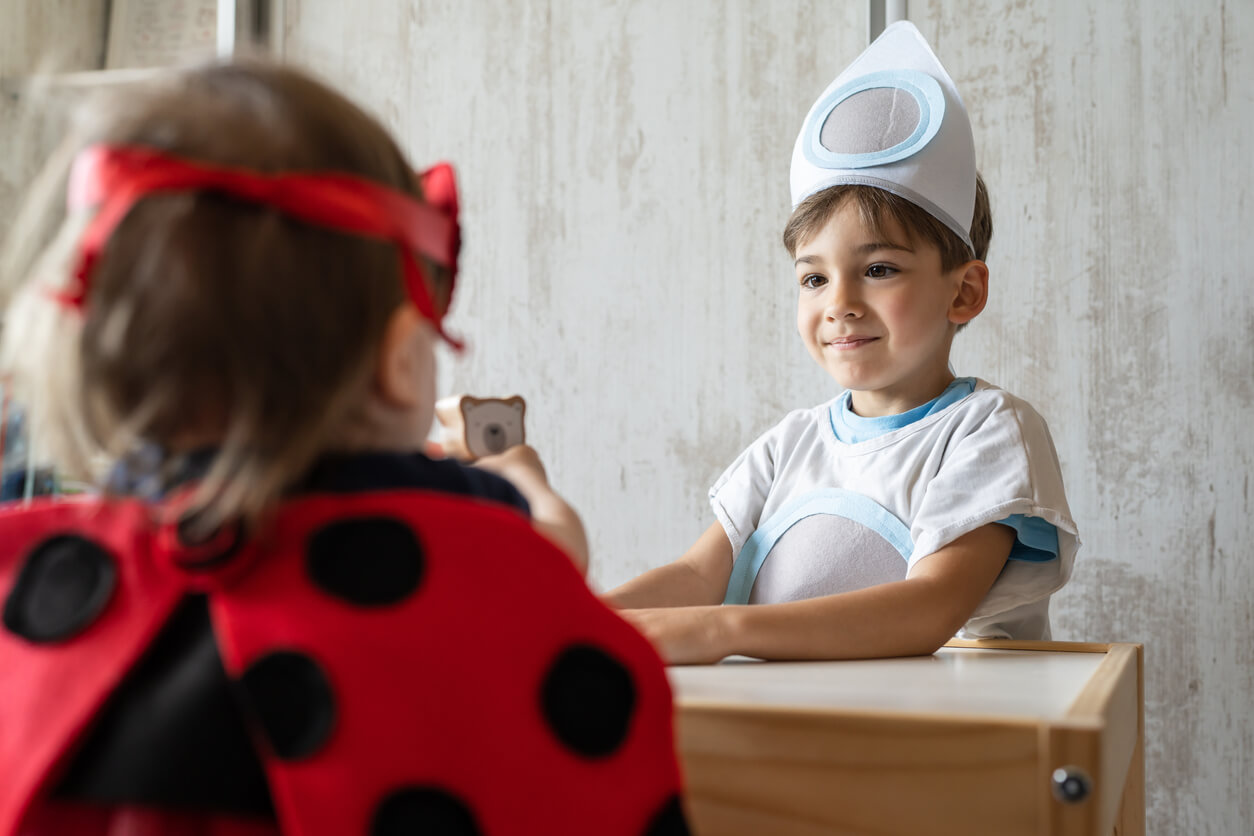5 Keys to Enhance Mental Flexibility in Children


Written and verified by the psychologist Maria Fátima Seppi Vinuales
Cognitive flexibility is a skill that allows us to analyze a situation and be able to change the course of action if necessary. If we think about it, then it’s an ability that we exercise every day, as it’s linked to survival itself. Let’s see what it is and how we can teach mental flexibility to children.
What is mental flexibility in children?
As in adults, when we talk about mental flexibility in children, we’re referring to the ability to adapt thinking to changing circumstances and the possibility of incorporating other points of view in a situation. This ability is also related to organization, planning, memory, and emotional management, among others. The benefits are multiple and among them, we find the following:
- Encourages creativity: Creativity is developed by being able to create, build, take apart, and start again. This applies to the ideas and thoughts that are put into operation during play, study, and learning.
- Facilitates teamwork: Mental flexibility allows children to accept that there are different ways to reach the same result, which facilitates coexistence and group work.
- Promotes empathy: Through mental flexibility, children can understand different circumstances.
On the other hand, rigidity is associated with dogmatism, that is, with the impossibility of getting out of a single idea. For this reason, we become “short-sighted”, while learning stagnates.
How can you tell if a child has difficulties with mental flexibility?
Of course, it’s not a question of giving absolute answers, but they must be compared in the light of a broader reading according to the child’s personality and context. However, some indicators that point to the need to work on cognitive flexibility are as follows:
- It’s difficult to change the course of action: This occurs because children remain obstinate in a position, even when it doesn’t work and they don’t get the results they desire.
- This child becomes frustrated or experiences emotional ups and downs: For example, when asked to change because circumstances have changed, the child shows frustration.
You may be interested in: Alternative Thinking, the Key to Mental Flexibility

5 keys to boosting mental flexibility in children
In regard to cognitive flexibility, it’s best to start stimulating it between the ages of 3 and 4. From that moment on, children are able to incorporate information and start looking for solutions to solve a problem. Here are some keys and activities to promote mental flexibility in children.
Use stories or games with questions
It’s best to play games that allow children to think in different scenarios and where they can make different choices. You can reinforce the activity by asking them to tell you why they choose one thing or another and provide some clues to broaden their vision. Probing the posture taken by the different participants is also a good alternative.
Doing things differently
For example, using the other hand to brush their teeth, changing some things around, or finding different uses for objects is a good way to encourage mental flexibility in children. We can also ask them to be the ones to establish a new routine.
Promote role-playing
Role-playing different characters not only helps develop mental flexibility in children but also imagination and empathy, to name a few qualities.

Encourage reading and writing
As they get older, do different activities with children that involve reading and writing. Both are linked to cognitive flexibility in different ways. For example, they learn that a letter can be used in different words or that spelling rules require changes in response to certain usages. So, cognitive flexibility will also be both a cause and a consequence of literacy skills.
Ask for their opinion and ask what they think
In those situations that involve it, you can ask the child what they would do or how they think a certain circumstance can be solved. This way, you not only make them the protagonist and make them feel important, but you also help them think about the different possibilities.
You may be interested in: How to Teach Problem-Solving Skills to Kids
A life skill
After over two years of the pandemic, if there’s one thing we have to keep in mind is that the only thing that’s certain is uncertainty and change. So, teaching children to adapt, plan, but be flexible is a very useful skill that will be with them forever. And more than once it will help them to solve all kinds of conflicts.
Mental flexibility will allow them to better tolerate changes and frustrations, so it will also be a gift for their emotional stability. Finally, cognitive rigidity is often at the base of biases in the way we interpret a situation. And that leads to multiple diseases and disorders, such as anxiety or depression. For example, those who suffer from discouragement often have a pessimistic view of life and are unable to generate other interpretations. In this regard, teaching cognitive flexibility is also an investment in their mental health.
Cognitive flexibility is a skill that allows us to analyze a situation and be able to change the course of action if necessary. If we think about it, then it’s an ability that we exercise every day, as it’s linked to survival itself. Let’s see what it is and how we can teach mental flexibility to children.
What is mental flexibility in children?
As in adults, when we talk about mental flexibility in children, we’re referring to the ability to adapt thinking to changing circumstances and the possibility of incorporating other points of view in a situation. This ability is also related to organization, planning, memory, and emotional management, among others. The benefits are multiple and among them, we find the following:
- Encourages creativity: Creativity is developed by being able to create, build, take apart, and start again. This applies to the ideas and thoughts that are put into operation during play, study, and learning.
- Facilitates teamwork: Mental flexibility allows children to accept that there are different ways to reach the same result, which facilitates coexistence and group work.
- Promotes empathy: Through mental flexibility, children can understand different circumstances.
On the other hand, rigidity is associated with dogmatism, that is, with the impossibility of getting out of a single idea. For this reason, we become “short-sighted”, while learning stagnates.
How can you tell if a child has difficulties with mental flexibility?
Of course, it’s not a question of giving absolute answers, but they must be compared in the light of a broader reading according to the child’s personality and context. However, some indicators that point to the need to work on cognitive flexibility are as follows:
- It’s difficult to change the course of action: This occurs because children remain obstinate in a position, even when it doesn’t work and they don’t get the results they desire.
- This child becomes frustrated or experiences emotional ups and downs: For example, when asked to change because circumstances have changed, the child shows frustration.
You may be interested in: Alternative Thinking, the Key to Mental Flexibility

5 keys to boosting mental flexibility in children
In regard to cognitive flexibility, it’s best to start stimulating it between the ages of 3 and 4. From that moment on, children are able to incorporate information and start looking for solutions to solve a problem. Here are some keys and activities to promote mental flexibility in children.
Use stories or games with questions
It’s best to play games that allow children to think in different scenarios and where they can make different choices. You can reinforce the activity by asking them to tell you why they choose one thing or another and provide some clues to broaden their vision. Probing the posture taken by the different participants is also a good alternative.
Doing things differently
For example, using the other hand to brush their teeth, changing some things around, or finding different uses for objects is a good way to encourage mental flexibility in children. We can also ask them to be the ones to establish a new routine.
Promote role-playing
Role-playing different characters not only helps develop mental flexibility in children but also imagination and empathy, to name a few qualities.

Encourage reading and writing
As they get older, do different activities with children that involve reading and writing. Both are linked to cognitive flexibility in different ways. For example, they learn that a letter can be used in different words or that spelling rules require changes in response to certain usages. So, cognitive flexibility will also be both a cause and a consequence of literacy skills.
Ask for their opinion and ask what they think
In those situations that involve it, you can ask the child what they would do or how they think a certain circumstance can be solved. This way, you not only make them the protagonist and make them feel important, but you also help them think about the different possibilities.
You may be interested in: How to Teach Problem-Solving Skills to Kids
A life skill
After over two years of the pandemic, if there’s one thing we have to keep in mind is that the only thing that’s certain is uncertainty and change. So, teaching children to adapt, plan, but be flexible is a very useful skill that will be with them forever. And more than once it will help them to solve all kinds of conflicts.
Mental flexibility will allow them to better tolerate changes and frustrations, so it will also be a gift for their emotional stability. Finally, cognitive rigidity is often at the base of biases in the way we interpret a situation. And that leads to multiple diseases and disorders, such as anxiety or depression. For example, those who suffer from discouragement often have a pessimistic view of life and are unable to generate other interpretations. In this regard, teaching cognitive flexibility is also an investment in their mental health.
All cited sources were thoroughly reviewed by our team to ensure their quality, reliability, currency, and validity. The bibliography of this article was considered reliable and of academic or scientific accuracy.
- Coni, A. G., Juric, L. C., & Andrés, M. L. (2010). Desarrollo de la flexibilidad cognitiva y de la memoria de trabajo en niños de 6 a 9 años de edad. Revista Mexicana de Investigación en Psicología, 12-19.
- Castro-Castiblanco, Y. M., & Zuluaga-Valencia, J. B. (2019). Evaluación de atención, memoria y flexibilidad cognitiva en niños bilingües. Educación y educadores, 22(2), 167-186.
This text is provided for informational purposes only and does not replace consultation with a professional. If in doubt, consult your specialist.








